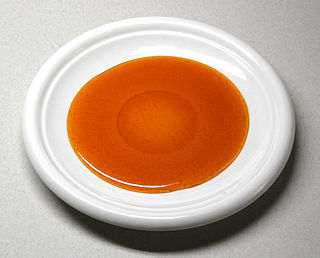
Confectionery is the art of making confections, which are food items that are rich in sugar and carbohydrates. Exact definitions are difficult. In general, however, confectionery is divided into two broad and somewhat overlapping categories: bakers' confections and sugar confections. The occupation of confectioner encompasses the categories of cooking performed by both the French patissier and the confiseur.

Caramel is an orange-brown confectionery product made by heating a range of sugars. It can be used as a flavoring in puddings and desserts, as a filling in bonbons, or as a topping for ice cream and custard.

A chocolate bar or candy bar is a confection containing chocolate, which may also contain layerings or mixtures that include nuts, fruit, caramel, nougat, and wafers. A flat, easily breakable, chocolate bar is also called a tablet. In some varieties of English and food labeling standards, the term chocolate bar is reserved for bars of solid chocolate, with candy bar used for products with additional ingredients.

Altoids are a brand of mints, sold primarily in distinctive metal tins. The brand was created by the London-based Smith & Company in the 1780s, and became part of the Callard & Bowser company in the 19th century. Their advertising slogan is "The Original Celebrated Curiously Strong Mints", referring to the high concentration of peppermint oil used in the original flavour lozenge. The mints were originally conceived as a lozenge intended to relieve intestinal discomfort.
Butterfinger is a candy bar manufactured by the Ferrara Candy Company, a subsidiary of Ferrero. It consists of a layered crisp peanut butter core covered in a chocolatey coating. It was invented by Otto Schnering of the Curtiss Candy Company in 1923. The name was chosen by a popularity contest.

Baby Ruth is an American candy bar made of peanuts, caramel, and milk chocolate-flavored nougat, covered in compound chocolate. It is distributed by the Ferrara Candy Company, a subsidiary of Ferrero.

Life Savers is an American brand of ring-shaped hard and soft candy. Its range of mints and fruit-flavored candies is known for its distinctive packaging, coming in paper-wrapped aluminum foil rolls.
Laffy Taffy is an American brand of taffy candies produced by the Ferrara Candy Company, a subsidiary of Ferrero. The candies are small, individually wrapped taffy rectangles available in a variety of colors and artificial fruit flavors, including banana, strawberry, green apple, grape, blueberry, watermelon, blue raspberry, and cherry. Rarer flavors include caramel apple, coconut, strawberries & cream, apple crisp, chocolate mousse, pumpkin donut, pineapple, guava, orange sorbet, and lemon raspberry. Discontinued flavors include fruit punch, mango, strawberry banana, peppermint, and hot cocoa.

Junior Mints are a candy brand consisting of small rounds of mint filling inside a semi-sweet chocolate coating, with a dimple on one side. The mints are produced by Tootsie Roll Industries, and packaged in varying amounts from the so-called 'fun-size box' to the much larger 12 oz. box.

Cadbury Roses are a selection of machine wrapped chocolates made by Cadbury. Introduced in the UK in 1938, they were thought to be named after the English packaging equipment company "Rose Brothers" based in Gainsborough, Lincolnshire, that manufactured and supplied the machines that wrapped the chocolates.

The D. L. Clark Company was founded in 1886 in Allegheny, Pennsylvania, now part of Pittsburgh, by David L. Clark (1864–1939), an Irish-born candy salesman. In 1921, Clark Brothers Chewing Gum Company was spun off as a separate corporation. In 1955, when the family-owned D. L. Clark company was sold to Beatrice Foods, they had production facilities in Pittsburgh and Evanston, Illinois. Beatrice sold it in 1983 to Leaf, and they in turn sold Clark in 1991, though Leaf retained the rights to Clark's Zagnut and P. C. Crunchers bars. The new owner, entrepreneur Michael P. Carlow, would operate it under the umbrella of the Pittsburgh Food & Beverage Company.
The Hollywood Candy Company, or Hollywood Brands, was an American confectionery company formed in Hollywood, Carver County, Minnesota, in 1912 by Frank Martoccio.

Bun Bars are a line of candy bars manufactured by Pearson's Candy Company of Saint Paul, Minnesota, and available in the United States. Despite the name, Bun Bars are not bars at all, but actually round and flat, containing a disc made of maple or vanilla-flavored creme, or caramel, coated in milk chocolate and topped with a roasted peanut-chocolate cluster.

A candy bar is a type of candy that is in the shape of a bar. The most common type of candy bar is the chocolate bar, including both bars made of solid chocolate and combination candy bars, which are candy bars that combine chocolate with other ingredients, such as nuts, caramel, nougat, or wafers.











